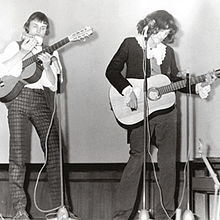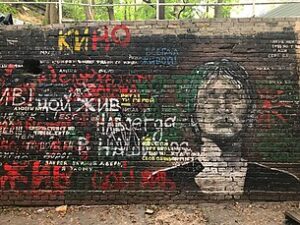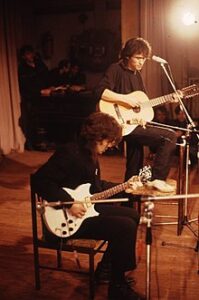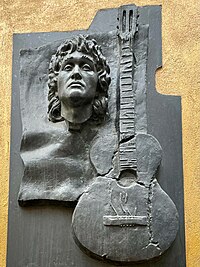From Childhood
Viktor Tsoi enjoyed art and music. He joined the rock group “Ward No. 6” at an early age and played bass guitar. He was an actor, musician, song writer, and artist who rose to fame in the 1980s. Young people all throughout the Soviet Union copied the well-known musician’s mannerisms and even attempted to look like him. His songs were very popular, and the movie “Needle,” in which Tsoi starred, became one of the top earners at the box office.
Wood carver and frontman of the Kino group
In June 1962, Viktor Tsoi was born in Leningrad. His father was an engineer, while his mother was a physical education teacher. Tsoi’s abilities were evident from kindergarten onwards: he was a skilled artist and could effortlessly mimic any tune, regardless of complexity, by just tapping his hand on the rhythm. The youngster should enroll in an art or music school, the professors said. But Tsoi didn’t start learning to sketch until he was twelve years old. Prior to that, he attended many schools as he moved with his mother to a different one each time she changed employment. Tsoi played bass guitar for the first time in a rock ensemble called “Ward No. 6” in the 1970s.

Tsoi enrolled at the Serov Art School four years later, but she was quickly dismissed due to her subpar academic standing. Tsoi attended night classes, obtained employment in a factory, and thereafter pursued studies at a technical school with a focus on wood carving. He continued to carve wooden Japanese netsuke sculptures throughout his life, a hobby he carried over from his education. Viktor Tsoi’s career choice was not by accident; he continued to have a passion for the fine arts. But then again, enjoy music. During the 1970s and 80s, Boris Grebenshchikov, Mike Naumenko from the band “Zoo,” Alexey Rybin from the band “Pilgrims,” Andrey Panov from “Automatic Satisfactories,” and other well-known members of the Leningrad underground were among his pals.
Viktor Tsoi personally performed in a number of bands in various Moscow rock flats. Tsoi also had his theatrical debut in the summer of 1981 at the “Trium” cafe in Leningrad. The band “Garin and the Hyperboloids” is thought to have formed following these gigs; the name was inspired by Alexei Tolstoy’s book “The Hyperboloid of Engineer Garin.” Oleg Valinsky, Viktor Tsoi, and Alexey Rybin were on the team. But shortly after Valinsky was inducted into the army, the organization changed its name, becoming known as the Kino group.
“Chief of Kamchatka”
In 1982, the band put out their debut album. It was documented for fifteen days. The musicians were required to take occasional leave from job and school since they worked at different hours of the day. The first Kino record was titled “45” because every song on the album lasted precisely forty-five minutes. Boris Grebenshchikov provided assistance with the recording; Aquarium group members served as session musicians. One year later, the members of two Soviet rock bands shared the stage for a sizable combined performance.

In the Kino group, the guitarist changed at this point. Following a fight with Tsoi, Alexey Rybin departed the squad, and Yuri Kasparyan was brought in to replace him. The musicians spent the entire summer of 1983 practicing in preparation for the Leningrad rock festival. Tsoi’s song “I declare my home a nuclear-free zone” was declared the finest after the performance, and the ensemble was named the festival’s laureate. The songs from the festival lineup were afterwards made available as a stand-alone CD titled “Chief of Kamchatka.”
Marianna Rodovanskaya, whom Viktor Tsoi married in 1984, was a musician with the Kino group as they were making their debut album. Legendary members of the Leningrad rock club, including Georgy Guryanov and Yuri Kasparyan, Boris Grebenshchikov and Alexander Titov, walked at their wedding with Tsoi. Alexander was Victor and Marianna’s son, born a year later.
The Kino group triumphed once more at the 1985 rock festival. Tsoi and the band started work on the following record, motivated by their success. The CD “This Is Not Love” quickly became available and was sent to every country in the Soviet Union. Young people started to know Viktor Tsoi’s name. The musician completed the recording of the album “Night” and debuted new music at a joint Moscow Rock Laboratory and Leningrad Rock Club concert. Tsoi, a well-known performer by then, was employed at a Veterans Avenue bathhouse. Subsequently, he obtained employment as a coal miner in a boiler room; today, “Kotelnaya. Kamchatka” is a club-museum.
Viktor Tsoi – actor, artist and rock legend
In addition to writing and performing music, Viktor Tsoi also did cinematic acting. His thesis picture, “Rock,” which was helmed by Alexei Uchitel, made his cinematic debut. Oleg Garkusha, Boris Grebenshchikov, Anton Adasinsky, and the ensembles “Aquarium,” “AVIA,” “Auktsion,” “DDT,” and “Kino” were all included. Tsoi later received increasingly frequent invitations to shoot. He acted in Sergei Solovyov’s “Assa” and Rashida Nugmanova’s “Yah Ha!” The main character in Nugmanov’s film “The Needle” was portrayed by the singer, Moreau. More than 14 million Soviets saw the movie in its first year of release, and Viktor Tsoi was named the greatest actor of 1989 by Soviet Screen magazine.

Yes, sometimes it’s entertaining to play a boor, for example. In my lifetime, I would never have acted in such a manner. Nevertheless, this is still quite close to the original character—no outfits or hairstyles were used throughout production. I moved into the picture after crossing the street. Naturally, Rashid created the director’s script after we received the original literary draft, but with some major alterations. Ultimately, very little of the original was left.
Viktor Tsoi on the “Needle” movie set. from an interview published in the “Young Leninist” newspaper
Drawing proceeded alongside music and cinematography, according to Viktor Tsoi. He belonged to the “New Artists” group, which focused on foreign initiatives such as pop art, comics, and graffiti by American artists, as well as the heritage of the avant-garde of the 1920s. This also had an impact on Viktor Tsoi’s colorful, expressive, and purposefully simple shapes. He painted anywhere and on whatever he had to because he didn’t have a workshop of his own. frequently—on bits of cardboard, paper, and even plastic.
Ten of Viktor Tsoi’s paintings were sold in America. He took part in shows organized by his creative group as well as the Leningrad artists’ exhibition in New York.
But Viktor Tsoi was more than anything a rock star to young Soviets. Following the publication of “Blood Type,” Tsoi’s music could be heard in every apartment building and in every yard. Many young people started acting and dressing “like Tsoi,” taking after the leader of the Kino group.
The songs “Aquarium,” “Alice,” “Strange Games,” and “Kino” were included on the collaborative album “Red Wave,” which was published in the US by many Soviet rock bands. American vocalist Joanna Stingray, who met Tsoi while visiting Leningrad, released the album. The album “A Star Called the Sun,” which was the only one the musicians of the Kino group produced in a professional studio, was published in the spring of 1989.
Between 1988 and 1990, Tsoi performed at several venues around the nation. He did tours throughout Denmark, the biggest rock festival in France, Back In The USSR, an Italian rock festival, and the Soviet-Italian rock festival, Melpignano.
Viktor Tsoi’s Muscovite collided violently with a bus on August 15, 1990. This incident took place in Latvia on the Sloka-Talsi route. Subsequently, it was discovered that the musician had dozed off while driving. He was laid to rest in Leningrad’s Bogoslovskoye cemetery. The band’s vocalist passed away, and Kino’s last record, “Black Album,” was issued following his passing. Fans of the rock group commemorate Viktor Tsoi Memorial Day on August 15.
